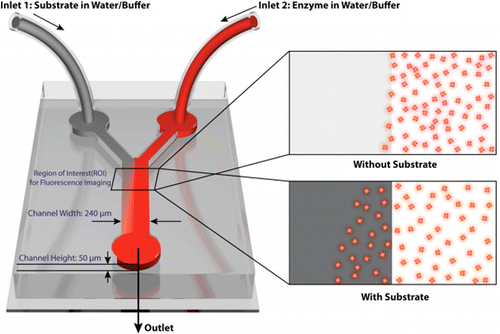A new genre of 'intelligent' micro- and nanomotors

Enzymes, workhorse molecules of life that underpin almost every biological process, may have a new role as "intelligent" micro- and nanomotors with applications in medicine, engineering and other fields. That's the topic of a report in the Journal of the American Chemical Society, showing that single molecules of common enzymes can generate enough force to cause movement in specific directions.
Peter J. Butler, Ayusman Sen and colleagues point out that enzymes—proteins that jump-start chemical reactions—are the basis of natural biological motors essential to life. Scientists long have wondered whether a single enzyme molecule, the smallest machine that could possibly exist, might be able to generate enough force to cause its own movement in a specific direction. "Positive answers to these questions," they explain, "have important implications in areas ranging from biological transport to the design of 'intelligent,' enzyme-powered, autonomous nano- and micromotors, which are expected to find applications in bottom-up assembly of structures, pattern formation, cargo (drug) delivery at specific locations, roving sensors and related functions."
They provide the positive answers in experiments with two common enzymes called catalase and urease. Catalase protects the body from harmful effects of hydrogen peroxide formed naturally in the course of life. Urease, found in many plants, converts urea to ammonia and carbon dioxide. The researchers show that these two enzymes, in the presence of their respective substrate (hydrogen peroxide or urea, which acts as fuel), show movement. More significantly, the movement becomes directional through the imposition of a substrate gradient, a form of chemotaxis. Chemotaxis is what attracts living things toward sources of food. The researchers also show that movement causes chemically interconnected enzymes to be drawn together; a form of predator-prey behavior at the nanoscale.
More information: "Enzyme Molecules as Nanomotors" J. Am. Chem. Soc., 2013, 135 (4), pp 1406–1414. DOI: 10.1021/ja3091615
Abstract
Using fluorescence correlation spectroscopy, we show that the diffusive movements of catalase enzyme molecules increase in the presence of the substrate, hydrogen peroxide, in a concentration-dependent manner. Employing a microfluidic device to generate a substrate concentration gradient, we show that both catalase and urease enzyme molecules spread toward areas of higher substrate concentration, a form of chemotaxis at the molecular scale. Using glucose oxidase and glucose to generate a hydrogen peroxide gradient, we induce the migration of catalase toward glucose oxidase, thereby showing that chemically interconnected enzymes can be drawn together.
Journal information: Journal of the American Chemical Society
Provided by American Chemical Society


















